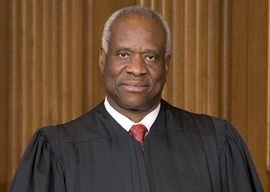
February 15, 2018

Clarence Thomas
Source: Wikimedia Commons
NEW YORK—I think Clarence Thomas made the right decision in the Wild Party House Case before the Supreme Court, but I think maybe my reasons would be different from his reasons.
In case you haven’t been hanging out in Northeast D.C. lately, here’s what happened.
A couple of people called the cops around 1 a.m. because there was loud music coming from a house near Anacostia Road and Blaine Street. I’ve never partied in this neighborhood, but pictures of it look like it’s made up of big clapboard houses and small brick apartment buildings. During oral arguments a couple of the Supreme Court justices called it “low-income.” So my first question is, How did they know that?
I don’t think they have signs on the street corners that say “You Are Now Entering a Low-Income Area, Demographic Details Available on Request.”
Conclusion: At least some members of the Supreme Court are partying in Northeast D.C. so often that they know the salaries and bank statements of individual homeowners and renters.
So one of the callers says he thinks the party is going on in a vacant house. He doesn’t know that for sure, but he says it used to be empty but now he’s seeing people going in and out of it. He says the noise is “raucous.”
I’m not sure what raucous means in this context, but I assume it means more than just music.
I’m looking at the current roster of Supreme Court justices, and I think the only ones who could possibly be raucous—the others are too old—are Gorsuch, Sotomayor, Kagan, Alito, Roberts, and Thomas, who wrote the majority opinion.
So the first thing that happens when the D.C. police arrive at the scene is one of the party animals looks out the window and immediately runs upstairs to hide.
I think you can see where this is going.
Since the case ultimately turns on what a police officer can reasonably conclude from what he sees and hears, we should list just a few of the things these officers saw and heard—and smelled—when they entered the house:
Marijuana aroma.
A massive number of empty beer cups. (The court papers nowhere defined “beer cup,” as opposed to vodka cup, whiskey cup, or tequila cup, but I’m going to assume it’s one of those fat red plastic cups with the white rim that we all know from keggers.)
Dirty floor. (So far this could be any college party.)
No furniture except “padded metal chairs.” (Again, I’m guessing, but it sounds like somebody borrowed some chairs when they were leaving the Alcoholics Anonymous meeting at the Methodist church.)
But none of these physical details matter as much as the overall impression of what Justice Thomas describes as “a makeshift strip club” set up in the main room of the house.
Until I read this opinion, I had never heard of a makeshift strip club—I know half the rednecks in North Texas and yet none of us ever thought of that—but Justice Thomas makes this conclusion according to abundant evidence. There were several women “wearing only bras and thongs” (normally I would stop him right there, because bras-and-thongs attire would be an indication of go-go dancers or sports-bar dancers, not strippers) who had “cash tucked into their garter belts.”
Okay, yeah, probably.
But here’s the part I don’t get: “The women were giving lapdances while other partygoers watched.”
The cops have entered the premises, people are scattering, unidentified party animals are running upstairs to hide, and somebody continued with a lapdance.
There are only two explanations for this:
(a) She doesn’t have that twenty-dollar-bill safely tucked into her garter belt yet so she thigh-crushes him, pushing his pelvis into the crease of the Alcoholics Anonymous padded metal chair.
(b) He’s had so much marijuana and plastic-cup beer that he’s in a priapic sensory overload preventing him from realizing that his lapdance is being witnessed by law enforcement.
Of course, there’s also the ACLU reason. The ACLU filed an amicus brief in this case on the side of the partygoers. By this reasoning the lapdance recipient would have been oblivious because he was merely engaging in recreational behavior on private property and a few cops happened to be joining in. I think we can rule out this reason.
But wait! There was “more debauchery upstairs.” And yes, I’m quoting the opinion, Justice Thomas used the word “debauchery.” In the upstairs portion of the makeshift strip club there were several men and a single nekkid woman. There was also a mattress on the floor, multiple open condom wrappers, and—I’m not sure why Clarence was fascinated by this particular detail—“a used condom on the windowsill.”
So far, no evidence of actual eyewitness debauchery, right? But this could be because one of the men upstairs was hiding in a closet and another one had locked himself in the bathroom and was refusing to come out.
By this time there are at least ten police officers on the scene and possibly as many as fifteen, because, let’s face it, you hear this on the radio you wanna see for yourself. Even with this show of force, the cops were outnumbered by the lapdance recipients, strippers, and alleged upstairs bare-mattress debauchees.
So they told everybody to sit down so they could be questioned one by one—except one person refused to sit down because the floor was too dirty.
To the question What are you doing here? the answers were:
(a) Bachelor party.
(b) Birthday party.
(c) I don’t know, I was invited.
To the question Who’s the bachelor? the answers were:
I don’t know.
To the question Whose birthday is it? the answers were:
I don’t know.
To the question Whose house is this? the answers were:
(a) I don’t know. (19 people)
(b) “Peaches.” (1 person)
(c) “Tasty.” (1 person)